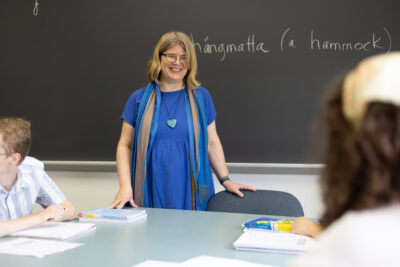“It’s why I teach, because really it means I get to be a student for life.”
What are your areas of research and teaching expertise?
Nordic colonialisms and postcolonial studies, comparative literature, Swedish/Gustavus settler history, Indigenous relations, global Nordic cinema, Swedish language and literature, diversity and social change in the global North
What is your teaching style?
Interactive, conversational, and sometimes intentionally goofy. Students learn better when they can laugh and feel at ease. I work hard to build a sense of community and trust in my classroom, whether the course is taught in English or in Swedish. This way, students can take the risks they need to take in order to learn and grow–intellectually and personally. While I anchor the day’s activities in the readings/assignments they’ve prepared for class, I also encourage students to draw on their own life experiences when engaging with the material. I’m constantly striving to practice active, sympathetic, and respectful listening, and I urge my students to do the same–especially when doing so is difficult.
Describe your “lightbulb moment.”
My favorite “lightbulb moment” happens when one or more of my students become(s) the teacher–even if just for a moment. The look of delighted surprise on their face(s) when I respond in wonder and enthusiasm to something they’ve said or written that I hadn’t considered before, or when they figure out an innovative approach to understanding or solving a problem, is everything to me. It’s why I teach, because really it means I get to be a student for life.
What tips do you have for student success?
DO THE WORK, whatever that means to you. You’re cheating yourself if you just try to fake your way through a course or an assignment. You can’t learn if you don’t engage, and you’ll get so much more out of going to class, meeting with professors, etc. if you come prepared. One of my mentors gave me this great advice once: Discipline is remembering what you want–and by discipline, I don’t mean punishment, but rather engaging in good learning habits. I get that students have other obligations — family, work, friends — but keep in mind that those obligations will be with you for your entire life. College is only now, for this brief period of time, and you want to make the most of it while you’re here.
What do you enjoy outside the classroom?
Reading, writing, cross-country skiing, traveling (especially with my teenage daughter), watching movies, baking (gluten-free these days), gardening, and camping with my family.
What campus traditions are your favorite?
Fika, for sure–the Swedish tradition of taking a break and sharing coffee and conversation with others. I also love Out of Scandinavia Week, an endowed program which has been happening every year, usually in the Spring semester, since 1989. We invite a famous artist (writer, visual artist, filmmaker, etc.) from the Nordic region to Gustavus to spend an entire week visiting classes, meeting with students, and doing a major event open to the general public (https://gustavus.edu/academics/departments/scandinavian-studies/out.php).
What is your favorite author/book?
That’s a tough one–there are so many! But I can narrow it down to two: Samlade dikter (Collected poems) by the Finland-Swedish author Edith Södergran (translated beautifully into English in an anthology titled Love & Solitude), and Audre Lorde, Sister Outsider.
What is your favorite class to teach?
You’re making me choose from among my darlings! But I guess I’d have to say SCA-285 Nordic Colonialisms and Postcolonial Studies, which is our only Scandinavian Studies course that meets a U.S. Identities and Difference general education requirement.
Where is your favorite place on campus/in St Peter?
Traverse des Sioux. It’s a beautiful spot right on the Minnesota River, north of campus off of Highway 169. It has a living and sorrowful history, including the signing of the 1851 treaty that ceded Dakota homelands to the U.S. government. I go there at least once a season, usually more, and sometimes I bring my students to the Treaty Site History Center museum that’s been built on the site. Walking along that river and through the woods anchors me to this place and replenishes my sense of purpose in my life and work.